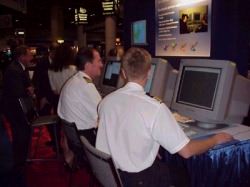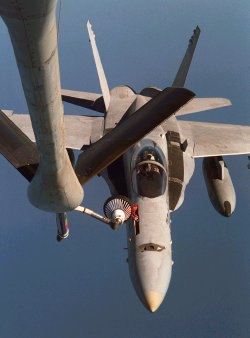|
The Interservice/Industry
Training, Simulation and Education Conference (I/ITSEC)
by Eric Larson, LT USN January 10th, 2000 |
||||
|
From November 29th through December 3rd, I attended the Interservice/Industry Training, Simulation and Education Conference (I/ITSEC) in Orlando, FL. I/ITSEC is a forum for the major players in the military simulation, training and education community to come together and discuss new concepts, demo current capabilities and engage in discussions about contemporary issues facing the community. Among other technologies, there were multiple combat aviation simulators there. The complexity ranged from the simple (literally, Microsoft Flight Simulator) to the high-end (360-deg dome, high-fidelity flight model, force-feel stick and seat, etc). And, surprisingly, Janes Information Group had a booth featuring, alongside many of their publications, USAF and F/A-18E.
 Four officers from the Swedish Airforce are helping ISD in showing the latest simulator for fighter controller training. Although I had responsibilities there (I was there to demo our product) I had opportunity to sample the major participants' entries including a dome simulator for the F/A-18E, a wrap-around simulator of the Block 52 F-16C, a front-hemisphere simulator of the F/A-18C, the JSF (cockpit and large monitor) and Janes F/A-18E. I'd like to record my impressions of these various simulations. Specifically, I would like to impart to you a sense of where commercially available flight simulations rank relative to simulation systems developed by industry and the government, often developed for several orders of magnitude more expense. F/A-18E The first simulator I flew was the F/A-18E STARS. I actually discovered it at the end of the second day of the conference, almost by accident, as the crew were just finishing with their last scheduled demos. I was wearing my OD flight jacket so they must have thought I was an aviator and immediately tried to get me into the van (I'm actually a Surface Warfare Officer - ship driver - but got the jacket through a friend in the supply department while serving in USS GEORGE WASHINGTON (CVN73)). By way of introduction, I'm a Navy Lieutenant, based in San Diego at Space and Naval Warfare Systems Command in the Modeling and Simulations division. I've been assigned to a Spruance-class destroyer and the GEORGE WASHINGTON. I graduated with a Bachelors in Aerospace Engineering from San Diego State and have been an avid flight sim enthusiast since high school (graduated '87). Yes, I wanted to be an airdale, but as heredity would have it, I got my mom's eyes and not my dad's. So, no air for me. For career reasons I selected the surface navy (and am kicking myself almost every day for not at least going NFO! :D) The simulator was installed in a van parked outside and consisted of a cockpit within ~9-ft dome. The user receives a short brief (you must close the dome and select RUN and FREEZE from within), dons a head-mounted sensor (located on a well-worn ballcap) and is given instructions on calibrating the projection device, which immediately followed. |
 The cockpit was complete with three MPDs mounted in a life-size cockpit (the touch screen display below the HUD was not present/functional). All of the buttons worked, but it wasn't an authentic cockpit - in place of real buttons and switches was a unitary membrane interface with printed buttons. The HOTAS system was fully functional with apparently authentic hardware. The user is presented with an oval scene projected on the dome - this is your "field of view." The projected field of view is about 40-deg wide with a region in the center about 10-deg wide with sharper definition (higher resolution). As the user moves his head, the view projected on the screen follows the movement. The projection follows head movements amazingly fast. I couldn't perceive any latency whatsoever and soon got acclimated to it. The field of regard was uninhibited outside of the cockpit - I could not move my head to point to a position where the projector couldn't view (wherever it was located - never did find it). To note - the body of the aircraft (wings, stabs, ordnance, etc) was not rendered, nor was a canopy frame represented. The HUD was not explicitly present, rather the HUD symbology was included in the image projected on the dome. Upon program initiation the nose of the aircraft was pointed nose-down into the ground at about 400 knots. Needless to say, an immediate pull to full aft (which was required a surprisingly heavy pull) was unable to prevent descent to 0-ft altitude! :D What followed was interesting - the fact that I had just penetrated the earth didn't phase the simulation in the least! I kept back stick and was presented with the underside view of the terrain - including some little cone-shaped pine trees! Soon I "broke out" of terra firma and gaining altitude like gangbusters. Soon I was able to inspect the terrain. The only way to describe the level of terrain detail in this particular simulation would be to reference some sims that the reader may remember: It reminded me of something between the early MS Flight Simulator terrain and MSI's Back to Baghdad. Very sparse, occasional changes in tan/brown color in a quilt-like fashion and a few cone-shaped trees populated the scene (they had a tendency to spring into existence not unlike GSC's Hornet 3.0). Very rudimentary to say the least. And it was only rendered out to about 5-10 miles, I'd say. There were no clouds whatsoever. Weather wasn't even modeled. Go to Part II.
|
|||
|
Copyright © 1997 - 2000 COMBATSIM.COM, INC. All Rights Reserved. Last Updated January 10th, 1999 |
||||
